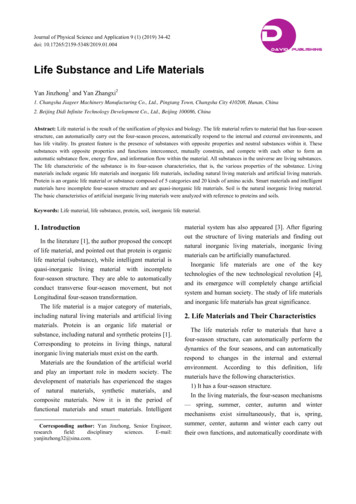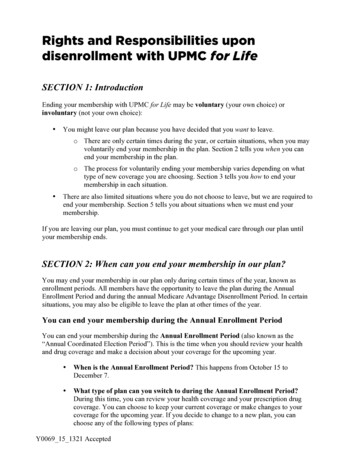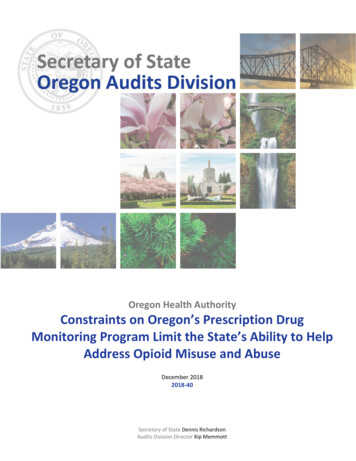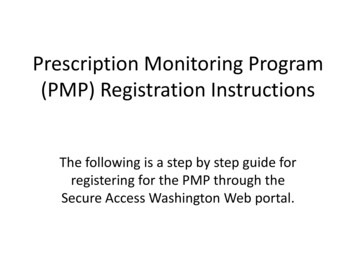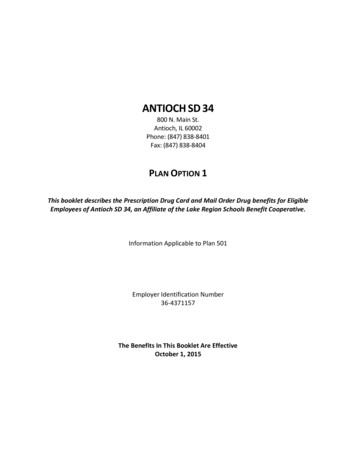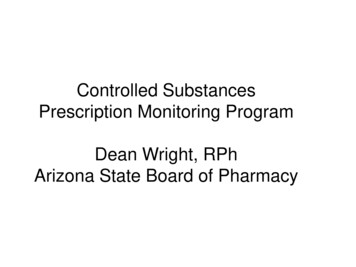
Transcription
Controlled SubstancesPrescription Monitoring ProgramDean Wright, RPhArizona State Board of Pharmacy
Controlled Substances Prescription Monitoring Program Arizona’s Forty-eighth Legislature passed H.B.2136 establishing a Controlled SubstancesPrescription Monitoring Program (CSPMP). Thebill was signed by the Governor on July 2, 2007and become effective on September 19, 2007. The new statutes, A.R.S. Title 36, Chapter 28 areavailable on the Board’s websitewww.azpharmacy.gov under the “CS-RxMonitoring Program” link. Our proposed rules arealso available under the same link.
Controlled Substances Prescription Monitoring Program A.R.S. § 36-2602 requires the ASBP to establish a controlledsubstances prescription monitoring program that: Includes a computerized central database tracking system trackthe prescribing, dispensing, and consumption of Schedule II, III,and IV controlled substances in Arizona, Assists law enforcement in identifying illegal activity related tothe prescribing, dispensing, and consumption of Schedule II, III,and IV controlled substances, Provides information to patients, medical practitioners, andpharmacists to help avoid the inappropriate use of Schedule II,III, and IV controlled substances, and Is designed to minimize inconvenience to patients, prescribingmedical practitioners and pharmacies while effectuating thecollection and storage of information.
Controlled Substances Prescription Monitoring ProgramPurpose of the Controlled Substances PrescriptionMonitoring Program: Improve the State’s ability to identify controlled substanceabusers or misusers and refer them for treatment Identify and stop diversion of prescription controlledsubstance drugsPrimary function of the Arizona State Board of Pharmacy: Provide a central repository of all prescriptions dispensedfor Schedule II, III, and IV controlled substances in Arizona
Controlled Substances Prescription Monitoring ProgramA.R.S. § 36-2604 Use and release of confidential informationC. The board may release data collected by the program to the following: 1. A person who is authorized to prescribe or dispense a controlled substance to assistthat person to provide medical or pharmaceutical care to a patient or to evaluate apatient. 2. An individual who requests the individual's own prescription monitoring informationpursuant to section 12-2293. 3. A professional licensing board established pursuant to title 32, chapter 7, 11, 13, 14,15, 16, 17, 18, 21, 25 or 29. Except as required pursuant to subsection B of this section,the board shall provide this information only if the requesting board states in writing thatthe information is necessary for an open investigation or complaint. 4. A local, state or federal law enforcement or criminal justice agency. Except as requiredpursuant to subsection B of this section, the board shall provide this information only ifthe requesting agency states in writing that the information is necessary for an openinvestigation or complaint. 5. The Arizona health care cost containment system administration regarding personswho are receiving services pursuant to chapter 29 of this title. Except as requiredpursuant to subsection B of this section, the board shall provide this information only ifthe administration states in writing that the information is necessary for an openinvestigation or complaint. 6. A person serving a lawful order of a court of competent jurisdiction.
Arizona State Board of PharmacyControlled Substances Prescription Monitoring Program October 2008: Arizona began collecting data fromresident and nonresident pharmacies. The firstreports were due on or before Friday October 17,2008 for the week ending October 11, 2008.Pharmacies were required to report their controlledsubstance data retroactively to April 1, 2008. October 2009: Began collecting data for dispensingpractitioners. There are about 1691 resident and nonresidentpharmacies reporting data and about 3800 dispensingpractitioners reporting data.
Data Collection What to Report– Dispenser’s DEA #– Name of patient, full address including city, state andzip code– Gender– Telephone #– DOB– Date prescription was written– Date Prescription was dispensed
Data Collection What to Report––––––Number of Refills if anyIndicate new or refillMetric qty of drug dispensedMethod of PaymentNDC # of drug dispensedPrescriber’s DEA #
Law EnforcementUse of the Monitoring Program Database Patient’s Prescription Profile Reports (Solicited Reports) Profile reports are only investigative tools Profile reports are not evidence and may not be used as evidence. Thereports provide investigators with the location of the filled prescription,which makes it easier to find the evidence Reports are based on prescription data collected from dispenser(pharmacies and dispensing practitioners). The Board cannot guaranteethe accuracy of the data, it merely collects and compiles the data. It isthe responsibility of the investigator to use the report to obtain the actualfilled prescription evidence from the dispenser
Law Enforcement Procedures forRequesting Access
Law Enforcement Procedures forRequesting Access
Access Notification Once your access request form is approved, ASBP’s technicalexpert, Health Information Designs, Inc. (HID) will notify you via twoseparate e-mails. The notifications will include the followinginformation: The first e-mail with include the CSPMP system logon ID you willuse to access the system and the database web link. The second e-mail will include the password you will use to accessthe system. * User login and password accounts are never to be shared. Before attempting to access the database, a requestor must have anaffidavit available. Sample affidavits are available on the CSPMPweb site and can be accessed by performing the following steps
Arizona State Board of PharmacyControlled Substances Prescription Monitoring Program Database access as of May 3, 2013: Practitioners: 4711 (21.3%) Pharmacists: 2396 (38.8%) Law Enforcement Investigators: 308 Board Investigators: 52 Practitioners, pharmacists, and law enforcement and board investigatorsfrom another state may also request access.
Arizona State Board of PharmacyControlled Substances Prescription Monitoring ProgramWho is using the database?Practitioners make 74.3% of the queriesPharmacists make 25.5% of the queriesLaw Enforcement make 0.14 % of the queriesHealthcare Boards make 0.06% of the queries
Arizona State Board of PharmacyControlled Substances Prescription Monitoring ProgramQueries - By Quarter for 2Queries – By Quarter for 3173Queries – By Quarter for 0240131Queries – By Quarter for 8186410349126
Arizona State Board of PharmacyControlled Substances Prescription Monitoring ProgramHow often is the database being used?Practitioners average 2071 queries per day.Pharmacists average 712 queries per day.Law enforcement agents average 3.9 queries per day.Healthcare Boards average 1.4 queries per day.Interstate Queries?Practitioners made 1200 and Pharmacists made 1466 in 3rdQuarter 2013
Arizona State Board of PharmacyControlled Substances Prescription Monitoring ProgramUnsolicited Reports Sent to -134/13169-197/1189-11
QUESTIONS?Arizona State Board of PharmacyWeb page: www.azpharmacy.govDean Wright, CSPMP DirectorArizona State Board of Pharmacy1616 W. Adams, Suite 120P.O. Box 18520Phoenix, AZ 85005602-771-2744Fax: 602-771-2748dwright@azpharmacy.gov
Use of the Monitoring Program Database Patient's Prescription Profile Reports (Solicited Reports) Profile reports are only investigative tools Profile reports are not evidence and may not be used as evidence. The reports provide investigators with the location of the filled prescription, which makes it easier to find the evidence
